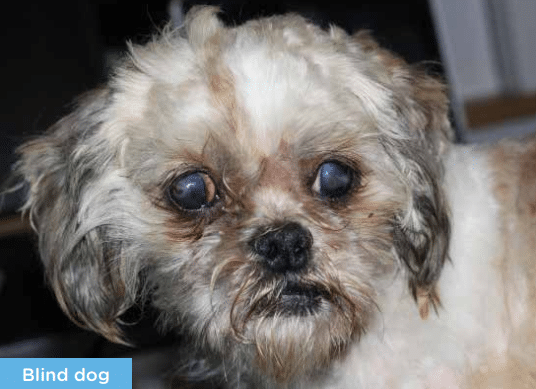Blind pet
Why did my pet become blind?
There are several reasons, why dogs and cats become blind, including but not limited, to birth defects, injury to the eyes, systemic diseases, breed related disorders, and complications after surgery. Whereas we always strive to preserve vision, a blind and painful eye is best removed (enucleated), in the interest of your pet’s well-being.
Do I need to put my pet to sleep, because it’s blind?
Most definitely NOT! Both dogs and cats have an extremely well-developed sense of smell and hearing, getting by with poor or no vision at all. Blindness is much harder on you than on your pet, since dogs and cats live “in the moment”, not overthinking what is happening to them. However, animals tend to react very sensitively to their owner’s emotional state, it is therefore important for you to keep up a positive mental attitude in the interest of your dog’s/cat’s welfare.

Are my kids in danger of my blind pet?
There is no simple answer to this question, as there are several factors involved, including the pet’s temperament and relationship to your kids before becoming blind. It is important for your children to understand your pet’s condition in order to avoid any problems. You can simply do this by blindfolding your toddler or explaining the situation to more grown-up children, in order for them to get an idea how it feels to be unable to see. This will improve their understanding of what to do and what not to do to your blind pet.
What can I do to make it easy on my pet to adjust to the new situation?
Toys and play
Being blind will improve the remaining senses (smell and hearing). Using squeaky toys or toys containing treats work well to help your pet follow and locate them and will keep your pet busy and entertained. It will strengthen your relationship to your pet and create an unbreakable bond.
Changes for indoors
We generally recommend keeping your furniture in dedicated areas, not making any great changes, so your pet can make a mental map of where things are.
Outlining a dedicated play area using a carpeted runner, will enable your dog to quickly learn where the edge of the runnr is and improve traction.
A “base-camp” made of a box or rug, will give your pet the opportunity to re-orient itself if it becomes confused.
We recommend placing a plastic mat with a rough surface where your pet consumes its food and water. This will make it easier to identify its location and the unique scent of the plastic mat will help guide your pet to the area. Water fountains work well for cats and dogs, since the bubbling sound of flowing water will help locate the water source.
Changes for outdoors
The most important changes to be made outside the house, is fencing off ponds or swimming pools, to avoid the risk of drowning. Wood shavings or tree bark scattered around trees and other obstacles will prevent your dog from accidentally bumping their head and avoid trauma and injury. Wind chimes positioned close to the front and back door of the house will help your pet access the house without help.
Changes in daily routines and habits
Consistent daily routines are key to giving your pet the necessary stability and confidence to adapt to this new life chapter. Any changes in daily routines should be performed gradually one step at a time. Rearranging the furniture in the living room without giving your pet the chance to get to know the newly arranged environment can easily shake its confidence and cause anxiety.
